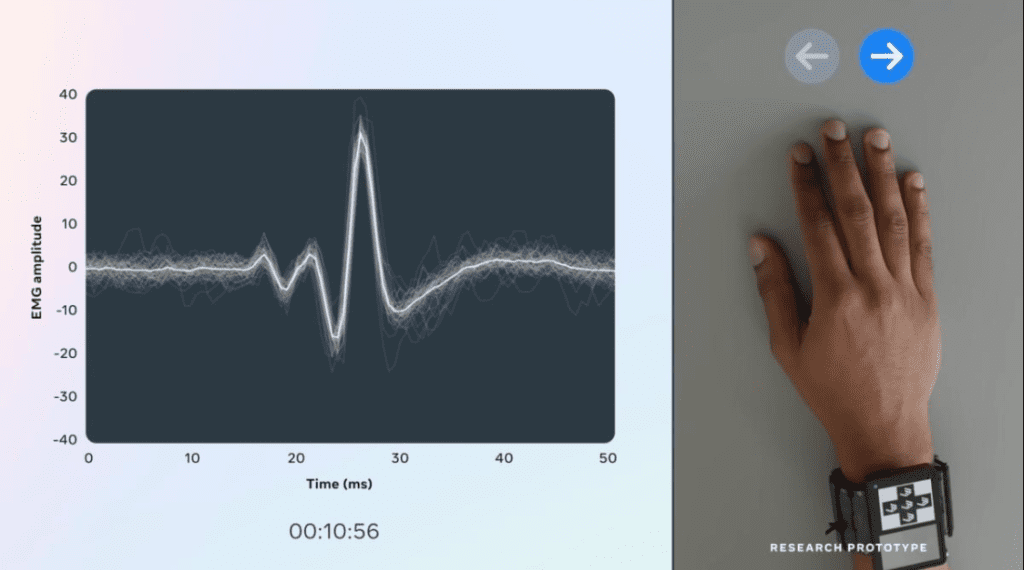- Mark Zuckerberg’s Meta is developing a wearable neural device that can interpret brain signals.
- The neural interface band is expected to launch in the next few years.
- Meta may also integrate the neural technology in future Meta Quest devices.
While Artificial Intelligence (AI) swiftly entered our world and made its way into every aspect of our lives, the next technological movement seems to belong to neural technology. Elon Musk-owned Neuralink is developing chips that will give humans ‘superpowers’ to control gadgets directly with their brains. The company recently started its first human trials. Musk reported that the first patient implanted with the Neuralink chip could control a computer mouse with his brain.
Not one to be left behind, tech billionaire Mark Zuckerberg is also invested in his own neural project at Meta. He is focused on making a wearable device which can decipher neural signals. The Meta CEO recently appeared on the Morning Brew Daily podcast last week. In the interview, he revealed that his company is developing a neural interface band that is capable of interpreting brain signals associated with hand movements and translating them into precise gesture commands.
To break it down in simple words, Meta is creating a smart band that can understand brain signals linked to hand movements and convert them into specific gestures. Zuckerberg called this project “one of the wilder things we’re working on”. He also poked fun at Elon Musk’s Neuralink, saying he wouldn’t want to put a chip in his brain until the tech is mature.
Also Read: AI-Generated Products Make Their Way Into TikTok and YouTube Videos
Meta’ New Neural Tech Project
Zuckerberg revealed that this wearable electromyography (EMG) band is an example of the future “power of AI” that can overcome the limitations of camera-based gesture recognition. He explained that with this band, “you’ll essentially be able to type and control something by thinking about how you want to move your hand, but it won’t even be big motions, so I can just sit here, basically typing something to an AI.”
Meta’s EMG wristband can read the nervous system signals your brain sends to your hands and arms. Zuckerberg has shown off this prototype wristband in a video before – not with the headset though. The Meta CEO described this futuristic neural device as being “close” to becoming a consumer product “within the next few years.”
Why An EMG Band?
Zuckerberg observes how people’s gestures are inconsistent and prone to errors for camera-based tracking but their brain signals are consistent. And those can be learned by the “neural interface [of the wearable EMG band] over time for each person.” This band will enable a completely private and discreet interface because even the smallest finger movements can produce a strong enough brain signal for the EMG to detect and interpret it as a specific gesture.
The Challenge
Meta will have to prove that this technology can go beyond a simple left-right swipe. According to Mark Zuckerberg, the company wants to make this wearable tech go beyond doing just left-right swipes to the advanced level of typing and interacting in mid-air with just your hands, similar to the tech shown in Tom Cruise’s “Minority Report.”
Therein comes the challenge of accessibility. By their very nature, AR and VR are very physical things. You have to physically move your arms around, make hand gestures, and push buttons – which can make them very inaccessible for folks with disabilities that affect mobility and dexterity. These kinds of brain signal sensors start to address this issue.

Rather than having to physically act out a gesture, one could think about doing it in their mind and the virtual interface would interpret these thoughts accordingly. Based on demos shown so far some movement is still required to use Meta’s neural interface so it’s far from the perfect solution, but it’s the first step to making this tech more accessible.
The Next-Gen Tech: Pros & Cons
Currently, if you want to communicate with the Ray-Ban Meta Smart Glasses via its ‘Look and Ask‘ feature or to respond to a text message you’ve been sent without getting your phone out, you have to talk to it. This is fine most of the time but there might be questions you want to ask or replies you want to send that you’d rather keep private.
The EMG wristband allows you to type out these messages using subtle hand gestures so you can maintain a higher level of privacy. However, as the podcast host notes, the wearable EMG band has issues of its own. Schools could have a harder time trying to stop students from cheating on tests. On the other hand, there are utility advantages too.
While this kind of wristband would also be useful in VR, Mark Zuckerberg has mostly talked about it being used with AR smart glasses. What works for the Ray-Ban Meta Smart Glasses is that they’re sleek and lightweight – similar to a regular pair of Ray-Bans. Adding cameras, sensors, and a chipset for managing hand gestures may affect this slim design. That is unless you put some of this functionality and processing power into a separate device like the wristband.
Meta In Neural Tech
Interestingly, Zuckerberg’s foray into neural technology extends beyond just the wearable band. He mentioned that although physical controllers in Quest products are currently a matter of preference, future Quest headsets would incorporate eye tracking. However, he emphasised that eye and hand tracking alone would be insufficient without additional elements such as a physical keyboard, controller, or “neural interface.”
Therefore, one could assume that Meta’s wearable neural band would align with Meta’s upcoming Quest devices when it launches. We might get to witness the integration of neural technology into these products. They will use brain signals from the wearable band to enhance hand-tracking accuracy during gaming or typing on a virtual keyboard.
This new neural system could be a major leap forward for privacy, utility and accessibility in Meta’s AR and VR tech. We’re excited to witness the final version of the wearable EMG band that will propel us into the future of neural technology.


